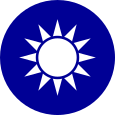Constitutional revisions and amendments that serve as the Constitution of Taiwan
The Additional Articles of the Constitution of the Republic of China are the revisions and constitutional amendments to the original constitution to meet the requisites of the nation and the political status of Taiwan "prior to national unification". The Additional Articles are usually attached after the original constitution as a separate document. It also has its own preamble and article ordering different from the original constitution.[1]
The Additional Articles are the fundamental law of the present government of the Republic of China on Taiwan since 1991, last amended in 2005.
Main provisions
The current Additional Articles of the Constitution entail 12 articles:
Article 1
Referendum on amendment to the Constitution and alteration of the national territory.
Article 2
President and the vice president .Article 3
Premier and the Executive Yuan .Article 4
Legislative Yuan .Article 5
Judicial Yuan .Article 6
Examination Yuan .Article 7
Control Yuan .Article 8
Remuneration and pay of the members of the Legislative Yuan .
Article 9
Local governments .Article 10
Fundamental national policy.
Article 11
Cross-Strait relations (rights and obligations between people of the free area and mainland China ).Article 12
Procedure for amending the Constitution.
Free area
The territory controlled by the Government of the Republic of China changed significantly after the Chinese Civil War , and the Republic of China could not hold elections in territories it did not control. Thus, the Additional Articles of the Constitution defines the Free Area (Chinese : 自由地區 Mandarin : Zìyóu Dìqū, Taiwanese : Chū-iû Tē-khu, Hakka : Chhṳ-yù Thi-khî) to be the territory and the people under the government 's effective jurisdiction. Whilst all residents of China are nominally citizens of the Republic,[citation needed only the citizens who have the right to abode in the Free Area may exercise the full civil and political rights, including right of abode and suffrage .
Direct presidential election
The Additional Articles requires direct election of the President by the citizens of the free area .[2] direct presidential election was held in 1996 . Under the original constitution, the President was elected indirectly by the National Assembly .
Government reform and reorganization
The Additional Articles of the Constitution reformed the government of the Republic of China from a parliamentary system to a de facto semi-presidential system . The National Assembly is de facto abolished, and its functions are exercised directly by the citizens of the Free area . The five-power governmental structure is retained, though it functions closer to the traditional Western trias politica
Constitutional referendum
A 2005 amendment regarding on referendum stated that a constitutional amendment or an alteration of the national territory has to be ratified by more than half (50%) of voters of the Free Area in a referendum after passed in the Legislative Yuan with a three-quarters majority . Before that, constitutional amendments and national territory alterations were ratified by the National Assembly .
Comparison of the governmental structure
Most of the amendments brought by the Additional Articles focuses on the mechanism of separation of powers among central governmental organs. The Additional Articles changed the form of government from parliamentary system to semi-presidential system , enhance the implementation of direct democracy and direct election , reduce the chambers of parliament , and simplify the hierarchy of local governments .[3]
History of amendments
The Additional Articles of the Constitution have been amended seven times since the 1990s.
Amendment
Process
Note
1st
Apr 22, 1991
Ratified by 1st National Assembly
Delegates elected in 1947 , 1969 , and 1986 . In the 583 delegates, 470 attended, 457 agreed.
May 1, 1991
Promulgated by 8th President Lee Teng-hui
Additional Articles established
2nd
May 27, 1992
Ratified by 2nd National Assembly
Delegates elected in 1986 and 1991 . In the 403 delegates, 285 attended, 277 agreed.
May 28, 1992
Promulgated by 8th President Lee Teng-hui
3rd
Jul 28, 1994
Ratified by 2nd National Assembly
Delegates elected in 1991 . In the 321 delegates, 220 attended, 215 agreed.
Aug 1, 1994
Promulgated by 8th President Lee Teng-hui
4th
Jul 18, 1997
Ratified by 3rd National Assembly
Delegates elected in 1996 . In the 333 delegates, 269 attended, 261 agreed.
Jul 21, 1997
Promulgated by 9th President Lee Teng-hui
5th Sep 3, 1999
Ratified by 3rd National Assembly
Delegates elected in 1996. In the 315 delegates, 214 attended, 211 agreed.
Sep 15, 1999
Promulgated by 9th President Lee Teng-hui
Mar 24, 2000
Voided by Justices of the Judicial Yuan
Constitutional Interpretation No. 499
6th
Apr 24, 2000
Ratified by 3rd National Assembly
Delegates elected in 1996. In the 314 delegates, 287 attended, 285 agreed.
Apr 25, 2000
Promulgated by 9th President Lee Teng-hui
7th (in effect) Aug 23, 2004
Proposed by 5th Legislative Yuan
Members elected in 2001 . In the 225 members, 198 attended, 198 agreed.
Jun 7, 2005
Ratified by the National Assembly
Delegates elected in 2005 . In the 300 delegates, 298 attended, 249 agreed.
Jun 10, 2005
Promulgated by 11th President Chen Shui-bian
Currently in force
—— (failed) Mar 25, 2022
Proposed by 10th Legislative Yuan
Members elected in 2020 . In the 113 members, 109 attended, 109 agreed.
Nov 26, 2022
Ratification failed in national referendum
Out of 19,239,392 eligible voters, only 5,647,102 agreed. See 2022 Taiwanese constitutional referendum

